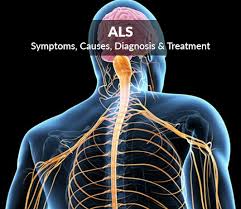Removing disease-causing expansion
Expansion in G4C2 RNA repeat in chromosome 9 open reading frame 72 (C9orf72) is one of the most common genetic causes of amyotrophic lateral sclerosis/frontotemporal dementia (ALS/FTD). To develop better therapeutics, Bush et al. developed and characterized a small molecule with dual function, able to bind the G4C2 expansion and to recruit an endonuclease to remove the expansion from the native RNA. The small molecule rescued typical cellular hallmarks of ALS/FTD in vitro in several patient-derived models and ameliorated ALS/FTD pathology in a mouse model. Removing pathological GC expansion using this dual-function small molecule could be an effective approach for treating C9orf72-mediated ALS/FTD.
Abstract
The most common cause of amyotrophic lateral sclerosis and frontotemporal dementia (c9ALS/FTD) is an expanded G4C2 RNA repeat [r(G4C2)exp] in chromosome 9 open reading frame 72 (C9orf72), which elicits pathology through several mechanisms. Here, we developed and characterized a small molecule for targeted degradation of r(G4C2)exp. The compound was able to selectively bind r(G4C2)exp’s structure and to assemble an endogenous nuclease onto the target, provoking removal of the transcript by native RNA quality control mechanisms. In c9ALS patient–derived spinal neurons, the compound selectively degraded the mutant C9orf72 allele with limited off-targets and reduced quantities of toxic dipeptide repeat proteins (DPRs) translated from r(G4C2)exp. In vivo work in a rodent model showed that abundance of both the mutant allele harboring the repeat expansion and DPRs were selectively reduced by this compound. These results demonstrate that targeted small-molecule degradation of r(G4C2)exp is a strategy for mitigating c9ALS/FTD-associated pathologies and studying disease-associated pathways in preclinical models.
INTRODUCTION
Amyotrophic lateral sclerosis (ALS) and frontotemporal dementia (FTD) are progressive neurodegenerative disorders that manifest by motor impairment and cognitive, behavioral, and language deficits. The most common genetic cause of ALS and FTD is a GGGGCC hexanucleotide repeat expansion (HRE; G4C2exp) in intron 1 of chromosome 9 open reading frame 72 (C9orf72), and the associated disease has been designated as c9ALS/FTD (1, 2). Whereas healthy individuals typically carry 2 to 30 G4C2 repeats, individuals with c9ALS/FTD typically harbor hundreds to thousands of repeats (3, 4). Various studies have shown that the RNA transcribed from the expanded repeat, r(G4C2)exp, is a toxic agent that plays a role in the development of c9ALS/FTD pathogenesis (fig. S1A, top). r(G4C2)exp (i) can operate by a gain-of-function mechanism in which the repeat binds and sequesters a subset of proteins affecting gene expression (1), (ii) is aberrantly translated into toxic dipeptide repeat proteins (DPRs) via repeat associated non-AUG (RAN) translation (5–9), and (iii) results in the formation of r(G4C2)exp-containing foci in a subset of central nervous system cells (9, 10). [Note: The C9orf72 antisense strand is also transcribed, producing r(G2C4)exp, which is also RAN-translated and forms foci (8, 9, 11).] Previous studies have shown that r(G4C2)exp-associated toxicity can be mitigated by small molecules that selectively bind r(G4C2)exp (fig. S1A, bottom) (12, 13).We hypothesized that a small molecule that eliminates the disease-causing agent, r(G4C2)exp, could ameliorate all c9ALS/FTD molecular defects, a substantial advantage over targeting a particular c9ALS/FTD pathway. This strategy could be further benefitted by the fact that r(G4C2)exp is located within an intron, not an open reading frame. More specifically, we envisioned a dual-functioning small molecule that selectively binds the three-dimensional (3D) structure formed by r(G4C2)exp and that recruits an endogenous ribonuclease (RNase) to cleave r(G4C2)exp, or an RNase recruiting chimera (RIBOTAC). A RIBOTAC would effect elimination of the toxic transcript by native RNA quality control pathways. That is, a chemical compound would unnaturally interface a transcript with RNA quality control mechanisms to eliminate a toxic RNA and alleviate disease-associated defects.To enable such an approach, we first designed and optimized a high-affinity compound that selectively recognizes r(G4C2)exp using structure-activity relationships and biophysical and structural analyses. The optimal compound, as determined through a battery of cellular assays, was then converted into a RIBOTAC by appending it to a small-molecule RNase L recruiter (14). By cleaving r(G4C2)exp, this c9ALS/FTD RIBOTAC ameliorated C9orf72 HRE-associated pathologies in cellular model systems, including patient-derived lymphoblastoid cell lines (LCLs), patient-derived induced pluripotent stem cells (iPSCs), iPSC-derived spinal neurons (iPSNs), and a c9ALS/FTD bacterial artificial chromosome (BAC) transgenic mouse model. Transcriptome-wide studies in iPSNs and in the transgenic mouse confirm that the RIBOTAC is selective for the expanded r(G4C2) repeat in intron 1 of C9orf72….







